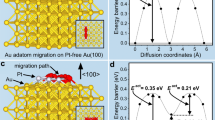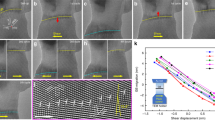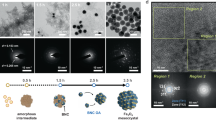Abstract
The impact of topological defects associated with grain boundaries (GB defects) on the electrical, optical, magnetic, mechanical and chemical properties of nanocrystalline materials1,2 is well known. However, elucidating this influence experimentally is difficult because grains typically exhibit a large range of sizes, shapes and random relative orientations3,4,5. Here we demonstrate that precise control of the heteroepitaxy of colloidal polyhedral nanocrystals enables ordered grain growth and can thereby produce material samples with uniform GB defects. We illustrate our approach with a multigrain nanocrystal comprising a Co3O4 nanocube core that carries a Mn3O4 shell on each facet. The individual shells are symmetry-related interconnected grains6, and the large geometric misfit between adjacent tetragonal Mn3O4 grains results in tilt boundaries at the sharp edges of the Co3O4 nanocube core that join via disclinations. We identify four design principles that govern the production of these highly ordered multigrain nanostructures. First, the shape of the substrate nanocrystal must guide the crystallographic orientation of the overgrowth phase7. Second, the size of the substrate must be smaller than the characteristic distance between the dislocations. Third, the incompatible symmetry between the overgrowth phase and the substrate increases the geometric misfit strain between the grains. Fourth, for GB formation under near-equilibrium conditions, the surface energy of the shell needs to be balanced by the increasing elastic energy through ligand passivation8,9,10. With these principles, we can produce a range of multigrain nanocrystals containing distinct GB defects.
This is a preview of subscription content, access via your institution
Access options
Access Nature and 54 other Nature Portfolio journals
Get Nature+, our best-value online-access subscription
$29.99 / 30 days
cancel any time
Subscribe to this journal
Receive 51 print issues and online access
$199.00 per year
only $3.90 per issue
Buy this article
- Purchase on SpringerLink
- Instant access to full article PDF
Prices may be subject to local taxes which are calculated during checkout




Similar content being viewed by others
Data availability
The data that produced and support the findings of this study are available from the corresponding author upon request.
Code availability
Strain and rotation mapping using real-space peak fitting, geometric phase analysis and other Fourier filtering measurements were performed using custom MATLAB scripts. The raw image data and analysis codes are available upon reasonable request.
References
Siegel, R. W. & Thomas, G. J. Grain boundaries in nanophase materials. Ultramicroscopy 40, 376–384 (1992).
Ovid’ko, I. A. Deformation of nanostructures. Science 295, 2386 (2002).
Read, W. T. & Shockley, W. Dislocation models of crystal grain boundaries. Phys. Rev. 78, 275–289 (1950).
Liu, H. H. et al. Three-dimensional orientation mapping in the transmission electron microscope. Science 332, 833–834 (2011).
Feng, B. et al. Atomic structures and oxygen dynamics of CeO2 grain boundaries. Sci. Rep. 6, 20288 (2016).
Lu, K. Stabilizing nanostructures in metals using grain and twin boundary architectures. Nat. Rev. Mater. 1, 16019 (2016).
Klapper, H. & Rudolph, P. in Handbook of Crystal Growth 2nd edn 1093–1141 (Elsevier, 2015).
Kwon, S. G. et al. Heterogeneous nucleation and shape transformation of multicomponent metallic nanostructures. Nat. Mater. 14, 215–223 (2015).
Dixit, G. K. & Ranganathan, M. Consequences of elastic anisotropy in patterned substrate heteroepitaxy. Nanotechnology 29, 365305 (2018).
Yang, B., Liu, F. & Lagally, M. G. Local strain-mediated chemical potential control of quantum dot self-organization in heteroepitaxy. Phys. Rev. Lett. 92, 025502 (2004).
Oh, M. H. et al. Galvanic replacement reactions in metal oxide nanocrystals. Science 340, 964–968 (2013).
Pan, A. et al. Insight into the ligand-mediated synthesis of colloidal CsPbBr3 perovskite nanocrystals: the role of organic acid, base, and cesium precursors. ACS Nano 10, 7943–7954 (2016).
Tsivion, D., Schvartzman, M., Popovitz-Biro, R., von Huth, P. & Joselevich, E. Guided growth of millimeter-long horizontal nanowires with controlled orientations. Science 333, 1003–1007 (2011).
Johnson, C. L. et al. Effects of elastic anisotropy on strain distributions in decahedral gold nanoparticles. Nat. Mater. 7, 120–124 (2008).
Shklyaev, O. E., Beck, M. J., Asta, M., Miksis, M. J. & Voorhees, P. W. Role of strain-dependent surface energies in Ge/Si(100) island formation. Phys. Rev. Lett. 94, 176102 (2005).
Chen, G. et al. Formation of Ge nanoripples on vicinal Si (1110): from Stranski–Krastanow seeds to a perfectly faceted wetting layer. Phys. Rev. Lett. 108, 055503 (2012).
Sneed, B. T., Young, A. P. & Tsung, C.-K. Building up strain in colloidal metal nanoparticle catalysts. Nanoscale 7, 12248–12265 (2015).
Foster, C. M., Pompe, W., Daykin, A. C. & Speck, J. S. Relative coherency strain and phase transformation history in epitaxial ferroelectric thin films. J. Appl. Phys. 79, 1405–1415 (1996).
Sun, Y. et al. Ambient-stable tetragonal phase in silver nanostructures. Nat. Commun. 3, 971–976 (2012).
Romanov, A. E. & Kolesnikova, A. L. Application of disclination concept to solid structures. Prog. Mater. Sci. 54, 740–769 (2009).
Gránásy, L., Podmaniczky, F., Tóth, G. I., Tegze, G. & Pusztai, T. Heterogeneous nucleation of/on nanoparticles: a density functional study using the phase-field crystal model. Chem. Soc. Rev. 43, 2159–2173 (2014).
Gaillac, R., Pullumbi, P. & Coudert, F. X. ELATE: An open-source online application for analysis and visualization of elastic tensors. J. Phys. Condens. Matter 28, 275201–275205 (2016).
Ophus, C., Ciston, J. & Nelson, C. T. Correcting nonlinear drift distortion of scanning probe and scanning transmission electron microscopies from image pairs with orthogonal scan directions. Ultramicroscopy 162, 1–9 (2016).
Hu, H., Gao, H. J. & Liu, F. Theory of directed nucleation of strained islands on patterned substrates. Phys. Rev. Lett. 101, 216102 (2008).
Zhong, Z. & Bauer, G. Site-controlled and size-homogeneous Ge islands on prepatterned Si (001) substrates. Appl. Phys. Lett. 84, 1922–1924 (2004).
Damodaran, A. R. et al. New modalities of strain-control of ferroelectric thin films. J. Phys. Condens. Matter 28, 263001 (2016).
Li, X., Wei, Y., Lu, L., Lu, K. & Gao, H. Dislocation nucleation governed softening and maximum strength in nano-twinned metals. Nature 464, 877–880 (2010).
Mariano, R. G., Mckelvey, K., White, H. S. & Kanan, M. W. Selective increase in CO2 electroreduction activity at grain-boundary surface terminations. Science 358, 1187–1192 (2017).
Fan, F. et al. Continuous-wave lasing in colloidal quantum dot solids enabled by facet-selective epitaxy. Nature 544, 75–79 (2017).
Gao, P. et al. Atomic-scale mechanisms of ferroelastic domain-wall-mediated ferroelectric switching. Nat. Commun. 4, 2791 (2013).
Acknowledgements
Synthesis and image analysis of the nanocrystal samples were supported by the Research Center Program of IBS in Korea (IBS-R006-D1 to T.H.; IBS-R006-G1 to Y.-E.S. and K.K. The theoretical part of this work was also supported by the US Department of Energy, Office of Science, Office of Basic Energy Sciences, Materials Sciences and Engineering Division, under contract number DE-AC02-05-CH11231 within the Physical Chemistry of Inorganic Nanostructures Program (KC3103 to A.P.A.). The computational work was supported by the Supercomputing Center/Korea Institute of Science and Technology Information with supercomputing resources including technical support (KSC-2014-C3-037 to K.K.). Work at the Molecular Foundry was supported by the Office of Science, Office of Basic Energy Sciences, of the US Department of Energy under contract number DE-AC02-05CH11231. Experiments at PLS-II were supported in part by MSIP and POSTECH.
Author information
Authors and Affiliations
Contributions
M.H.O., M.G.C., A.P.A. and T.H. conceived the research. M.H.O. and M.G.C. designed and performed the experiments and analysed the results. I.P. and K.K. performed the density functional theory calculations and analysis. Y.P.K. and S.M. conducted the computer-vision-based image processing of HAADF-STEM images. C.O. conducted the strain tensor measurements for the HAADF-STEM micrographs. M.G.K. and B.J. contributed to the analysis of X-ray absorption spectroscopy and X-ray photoelectron spectroscopy data, respectively. D.Y.C., J.M.Y., D.K., X.W.G. and Y.-E.S. discussed and commented on the results. J.J. and J.H. prepared the samples for the TEM analysis. M.H.O., M.G.C., D.K., A.P.A. and T.H. wrote the manuscript. A.P.A. and T.H. supervised the project. All the authors commented on the manuscript.
Corresponding authors
Ethics declarations
Competing interests
The authors declare no competing interests.
Additional information
Peer review information Nature thanks Laura Bocher, Yong Ding and the other, anonymous, reviewer(s) for their contribution to the peer review of this work.
Publisher’s note Springer Nature remains neutral with regard to jurisdictional claims in published maps and institutional affiliations.
Supplementary information
Supplementary Information
This file contains Supplementary Methods, Supplementary Discussion, Supplementary Figures 1–17, Supplementary Table 1 and References.
Rights and permissions
About this article
Cite this article
Oh, M.H., Cho, M.G., Chung, D.Y. et al. Design and synthesis of multigrain nanocrystals via geometric misfit strain. Nature 577, 359–363 (2020). https://doi.org/10.1038/s41586-019-1899-3
Received:
Accepted:
Published:
Issue Date:
DOI: https://doi.org/10.1038/s41586-019-1899-3
This article is cited by
-
Time-resolved Brownian tomography of single nanocrystals in liquid during oxidative etching
Nature Communications (2025)
-
Regioselective epitaxial growth of metallic heterostructures
Nature Nanotechnology (2024)
-
Imaging 3D chemistry at 1 nm resolution with fused multi-modal electron tomography
Nature Communications (2024)
-
A robust synthetic data generation framework for machine learning in high-resolution transmission electron microscopy (HRTEM)
npj Computational Materials (2024)
-
Probing the atomically diffuse interfaces in Pd@Pt core-shell nanoparticles in three dimensions
Nature Communications (2023)



